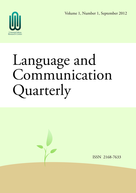


Volume 13 Issues 1-2 (2024-06-30)
Volume 10 Issues 1-4 (2021-12-31)
Volume 9 Issues 1-4 (2020-12-31)
Volume 8 Issues 1&2 (2019-06-30)
Volume 7 Issues 3&4 (2018-12-31)
Volume 7 Issues 1&2 (2018-06-30)
Volume 6 Issues 3&4 (2017-12-31)
Volume 6 Issues 1&2 (2017-06-30)
Volume 5 Issues 3&4 (2016-12-31)
Volume 5 Issues 1&2 (2016-06-30)
Volume 4 Issues 3&4 (2015-12-31)
Due to the lack of immediate teacher feedback on students' essays caused by heavy teaching loads, an approach to integrating peer feedback into EFL writing classrooms in Chinese colleges has been introduced to enhance students' writing abilities. This approach involves eight steps: peer feedback training at the beginning of the semester, students completing the first draft of their writing, the teacher providing feedback on three to four writing samples, the teacher sharing this feedback with the class, students giving feedback on their peers' essays, the teacher coding the feedback samples, the teacher sharing the coding results with the class, and finally, students completing the second draft based on the feedback. These steps are repeated for each writing task. This approach aims to provide EFL teachers with practical implications on how to effectively train students' writing abilities through the integration of peer feedback.
This article examines the role of English creative writing in the international spread of Chinese cultural narratives, exploring both the opportunities and challenges faced by Chinese authors in conveying their traditions, values, and histories through the English language. As globalization and the rise of English as a global lingua franca have reshaped the literary landscape, Chinese authors have increasingly turned to English to reach a broader, international audience. This article delves into the process of translating Chinese culture into English creative writing, highlighting how authors navigate linguistic and cultural barriers while adapting their cultural narratives for a global readership. Through case studies of contemporary Chinese authors, including Ha Jin and Yiyun Li, the article explores how their works serve as platforms for cultural exchange, providing new perspectives on Chinese society and history. Additionally, the article examines the challenges of linguistic translation, cultural misunderstandings, and market pressures, and discusses how these factors influence the global reception of Chinese literature. Ultimately, the article underscores the potential of English creative writing as a tool for reshaping the global perception of China, fostering cross-cultural dialogue, and facilitating the broader dissemination of Chinese culture worldwide.